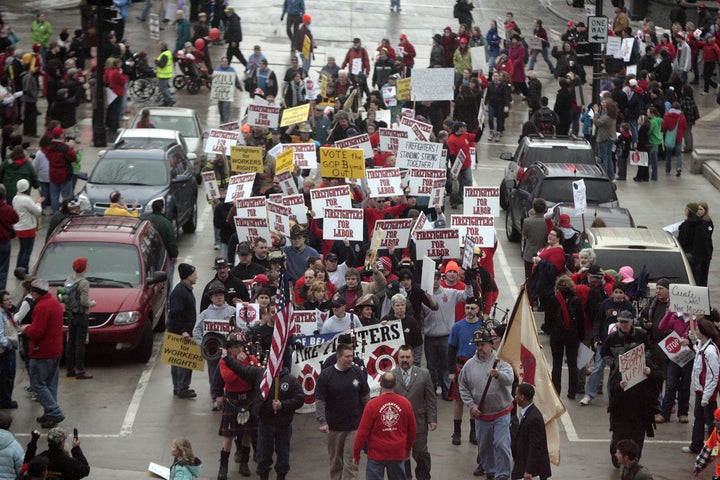
WASHINGTON - With protests surging in Wisconsin over a law that President Obama described as an "assault on unions," two new surveys show very different impressions of public employee labor unions among Americans. One finds a net positive rating of unions that represent people who work for state or local governments, while the other finds a two-to-one majority expressing opposition to the notion of public employee unions should "bargain for higher pay, benefits and pensions."
The difference, as usual, hangs on the wording of the questions: Narrow majorities of Americans continue to approve of unions, including public employee unions, though majorities also react negatively to efforts to expand union influence or benefits.
The first and far more comprehensive survey was conducted February 2-7 by the Pew Research Center among 1,385 adults. They found favorability ratings of unions at "their lowest level in a quarter century" yet still net positive -- 45 percent rate unions favorably and 41 percent rate them unfavorably.
The Pew Research survey probed more specifically for feelings about both government and private sector unions. They found a net positive rating (48 percent favorable, 40 percent unfavorable) for "unions that represent workers for state and local governments." The ratings of unions that represent "people who work for private companies" was very similar (48 percent favorable, 37 percent unfavorable).
They also asked about how Americans typically react to "a disagreement between state or local governments and unions that represent government workers." Slightly more (44 percent) said they side with the unions than side with the governments (38 percent).
The second survey was conducted February 4-8 by Clarus Research Group among 1,001 registered voters. It asked just one question about unions, which according to a Clarus spokesman was paid for by the company and "not done for any client, political group or outside interest." The company's clients include corporations and non-profit advocacy groups.
Do you think government employees should be represented by labor unions that bargain for higher pay, benefits and pensions, or do you think government employees should not be represented by labor unions?Should 29%
Should not 64%
So Clarus finds greater than two to one opposition to the government employee unions that earn net positive ratings on the Pew Research survey. The questions asked by Clarus and Pew Research are obviously different, but still appear to produce contradictory results. Could a large number of Americans rate public employee unions favorably while simultaneously believing they should not exist?
One explanation for the conflict may be the way the Clarus poll characterizes public unions as bargaining "for higher pay benefits and pensions" (emphasis added). While that phrase accurately describes the historic mission of unions generally, public employee unions -- including those in Wisconsin -- have more recently negotiated to limit reductions in pay, benefits and pensions. Some respondents may have reacted more to the notion of pay and benefit increases than the notion of union representation generally.
Clarus Research President Ron Faucheux concedes that the language about higher pay and benefits "could have influence" but notes that their survey was conducted well before the Wisconsin story heated up. Nevertheless, he points to the message of Wisconsin's Republican Governor Scott Walker, "which is that government unions are pushing up these costs," a message that amounts to "the unions versus the taxpayers." The Clarus question, he adds, "gives you sense of the political potency of that message of the role of government unions as it relates to budget issues and cutting spending and deficits."
More generally, Faucheux argues that apparent conflict in the results is a "classic case" of how people can look at an issue from different perspectives depending on "how a question is worded." He sees two such perspectives at work here: a desire for "public employees to be treated fairly and be compensated fairly," but also "skepticism about unions representing public employees."
Other recent surveys do show conflicting attitudes toward unions generally. The recent Pew Research survey, for example, shows a majority of Americans perceive unions as having a positive effect on "the salary and benefits of union workers" (53 percent positive, 17 percent negative) and the "working conditions for all American workers" (51 percent positive, 17 percent negative). Yet they find more division on the impact of unions on "workplace productivity" (34 percent positive, 30 percent negative), the "availability of goods jobs in America" (32 percent positive, 33 percent negative) and the "ability of American companies to compete globally"" (24 percent positive, 36 percent negative).
A Gallup survey conducted last August found results similar to those obtained by Pew Research. More Americans had a positive impression of labor unions (52 percent) than negative (41 percent), although that result was "the second lowest approval rating in Gallup's 70-year history of this trend."
A particularly interesting question on that Gallup survey, in light of both the Clarus question and the ongoing controversy in Wisconsin, concerned whether labor unions should have more, less or the same influence as they have today. Forty percent want to see unions have less influence, 29 percent want unions to have more influence and 27 percent want it to stay the same.
Imagine if that question had offered just two possible responses: Had it been a choice between less influence versus more or the same influences, a majority (56 percent) would sided with the unions. But had it been a question of more influence versus the same or less influence, a larger majority (69 percenr) would have taken the anti-union position.
